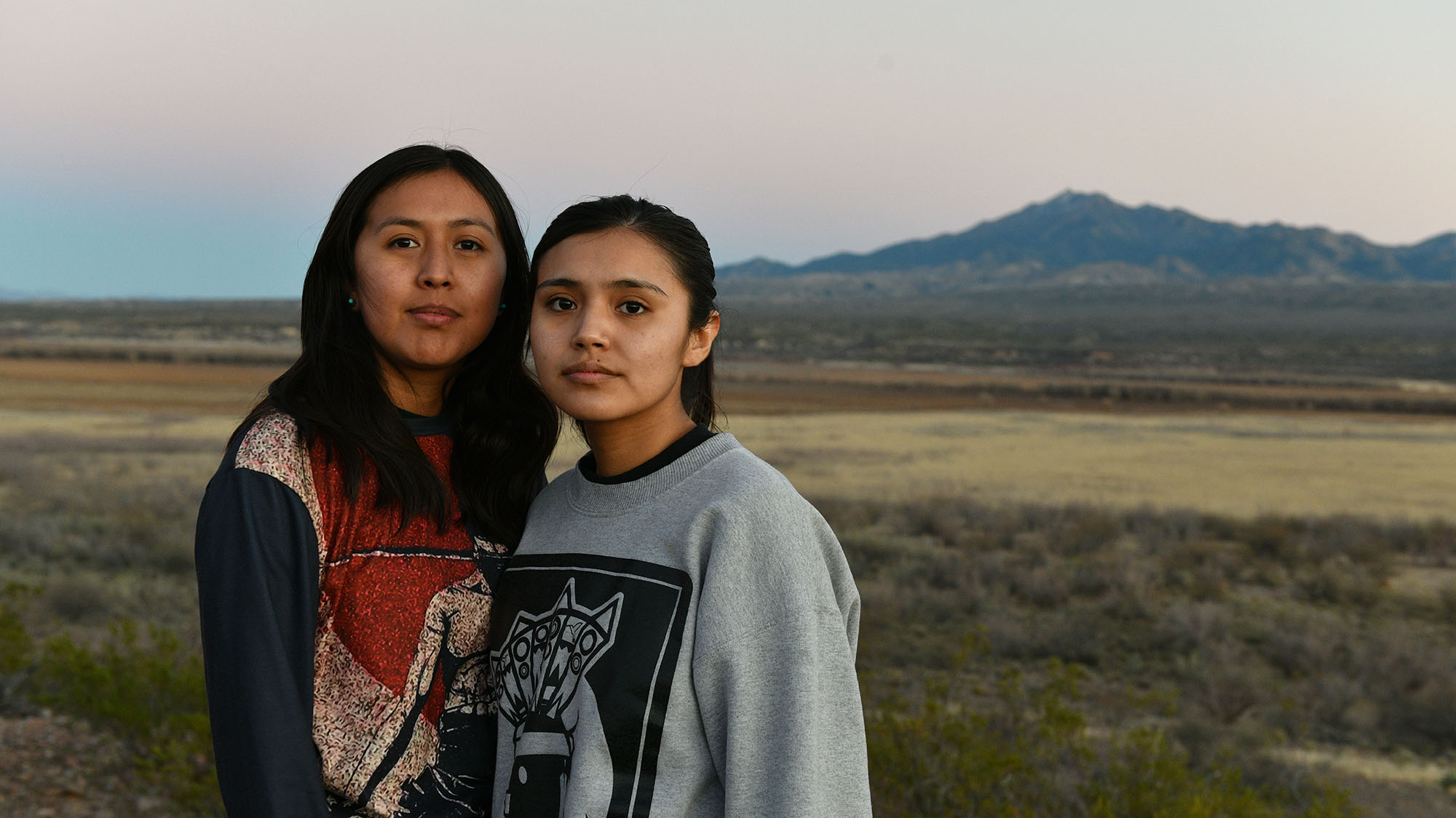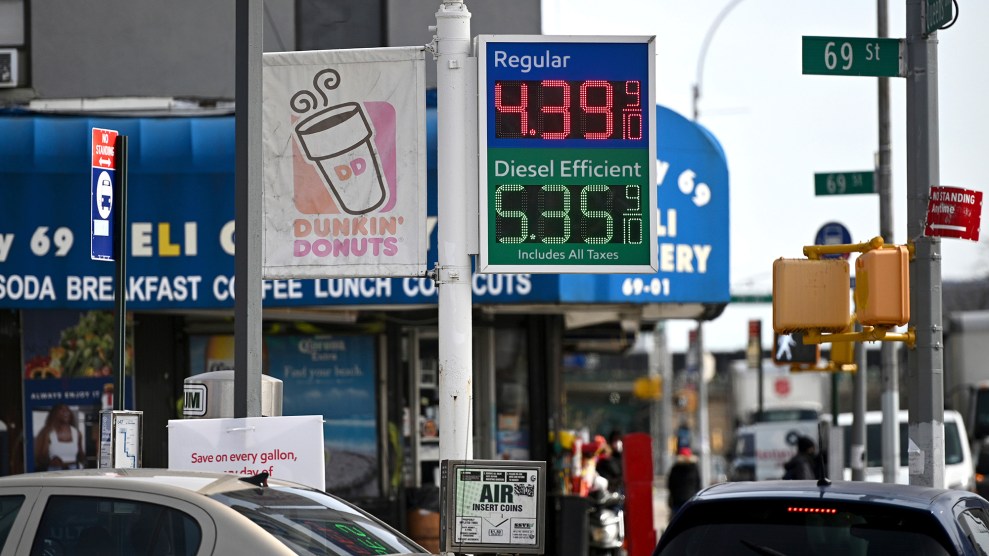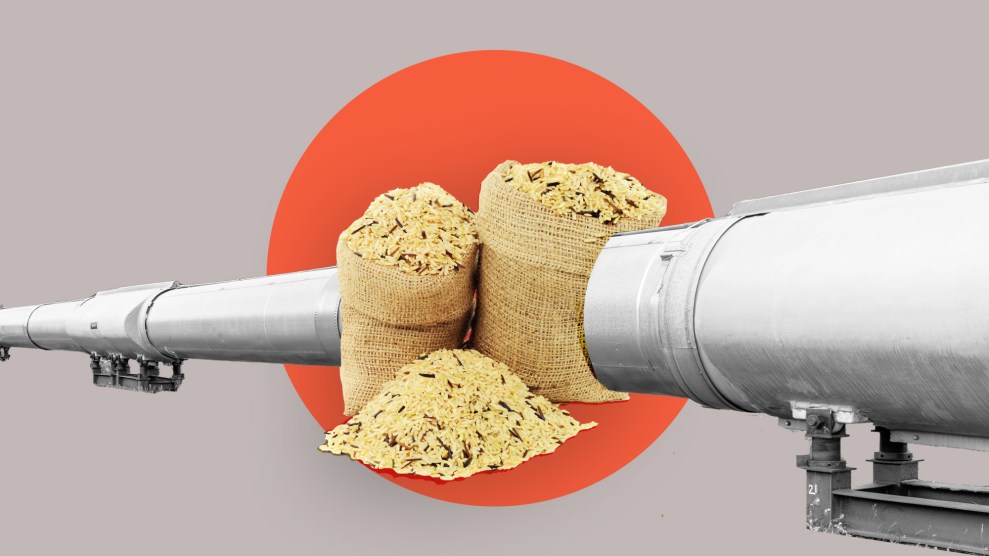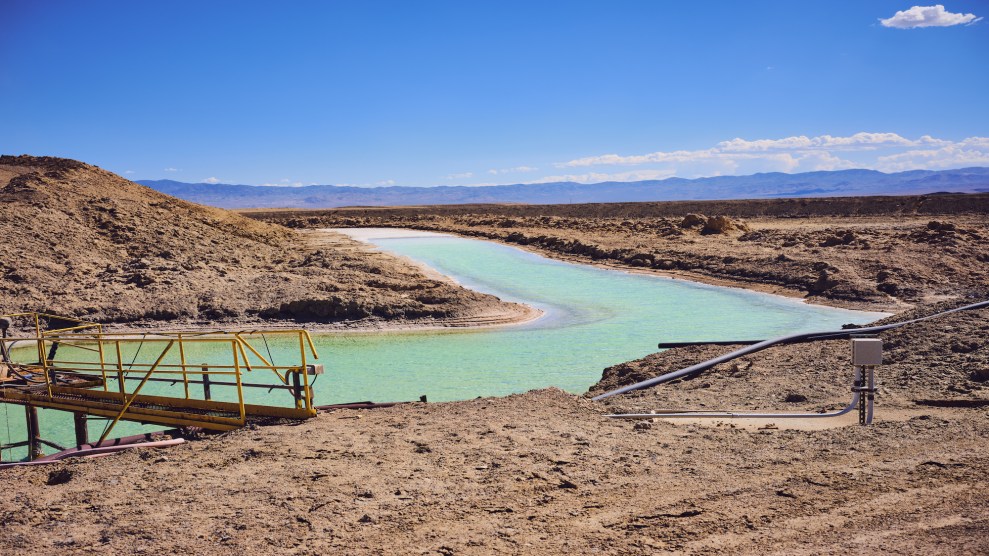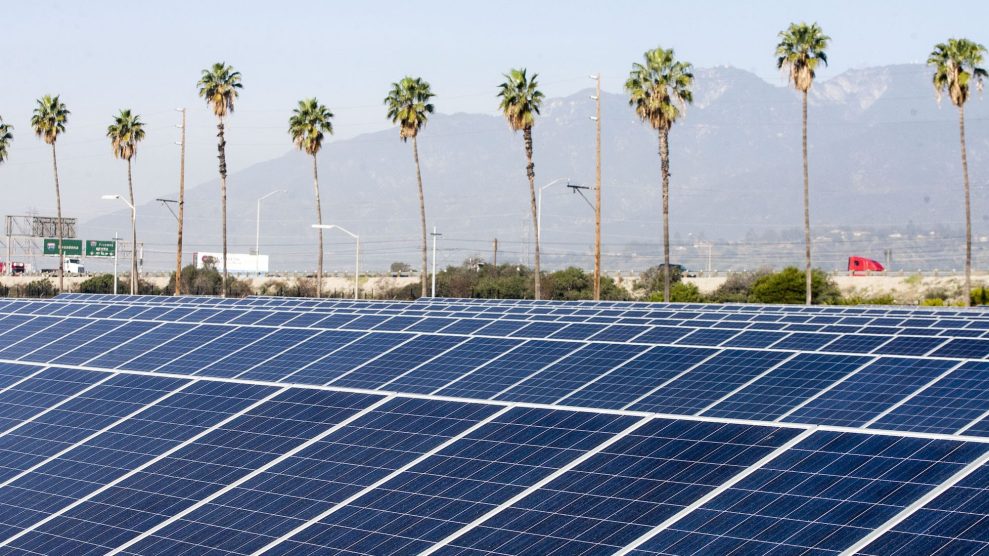The sun has already dipped behind southeast Arizona’s dusty blue Mescal Mountains, but for sisters Naelyn and Nizhoni Pike, huddled by a fire shooting sparks into the darkening desert, excitement lies ahead. In a few minutes, they will join a dozen runners on the first leg of a brisk 55-mile relay. Over the course of three days, they’ll traverse this arid valley where their ancestors were once imprisoned, and climb through the San Carlos Apache Indian Reservation, which they call home, and into the Tonto National Forest, to a site they consider their most sacred, where Naelyn has said she feels “free to be Apache”: Chi’chil Bildagoteel, an Apache name describing a place where acorns grow.
The run is not a race, but rather a moving protest in support of this rugged and exquisite patch of high desert mesa commonly referred to as Oak Flat. The sisters are running because they hope it can help stop a mining company called Resolution Copper from wiping it off the map.
Preparations started months ago, but as Naelyn, 22, explains over the thumping drums of a blessing ceremony, “it’s today where I feel like it really begins, the spirituality part of it.”
The sisters and their fellow Western Apaches go to Oak Flat to honor their Ga’an, the guardians or messengers between their creator and the physical world, who dwell there. This mesa also sits on a copper deposit so robust that miners brag it could meet a quarter of the United States’ needs. Copper has special currency in the push toward renewable energy and electric cars. As demand for the metal rises, so will thorny dilemmas about what will be destroyed in the name of green energy. Oak Flat, analysts argue, is the most promising new source of copper in the country. But if Resolution Copper can pull off a plan that would turn Oak Flat into a 2-mile-wide crater, Nizhoni, 21, says, “it’s gonna leave a hole in the Earth and a hole in all our hearts.”
It’s almost time for the run to begin. Naelyn and Nizhoni’s grandfather, Wendsler Nosie Sr., the founder of a group called Apache Stronghold, serves as ringleader, drawing the runners into a tight circle around the fire. They’ll cover more than 10 miles tonight, passing off a staff adorned with dangling eagle feathers. Nosie’s 8-year-old granddaughter, Wendslyn, a girl so fast she’s won races against high schoolers, will start. “Let’s go!” Nosie shouts, as Naelyn and Nizhoni jump into the bed of a brawny pickup truck that will accompany the runners. I watch a rose-gold moon rise over the horizon. And then Wendslyn shoots by, her fuchsia sneakers flying and her waist-long ponytail bobbing as she disappears into the night.
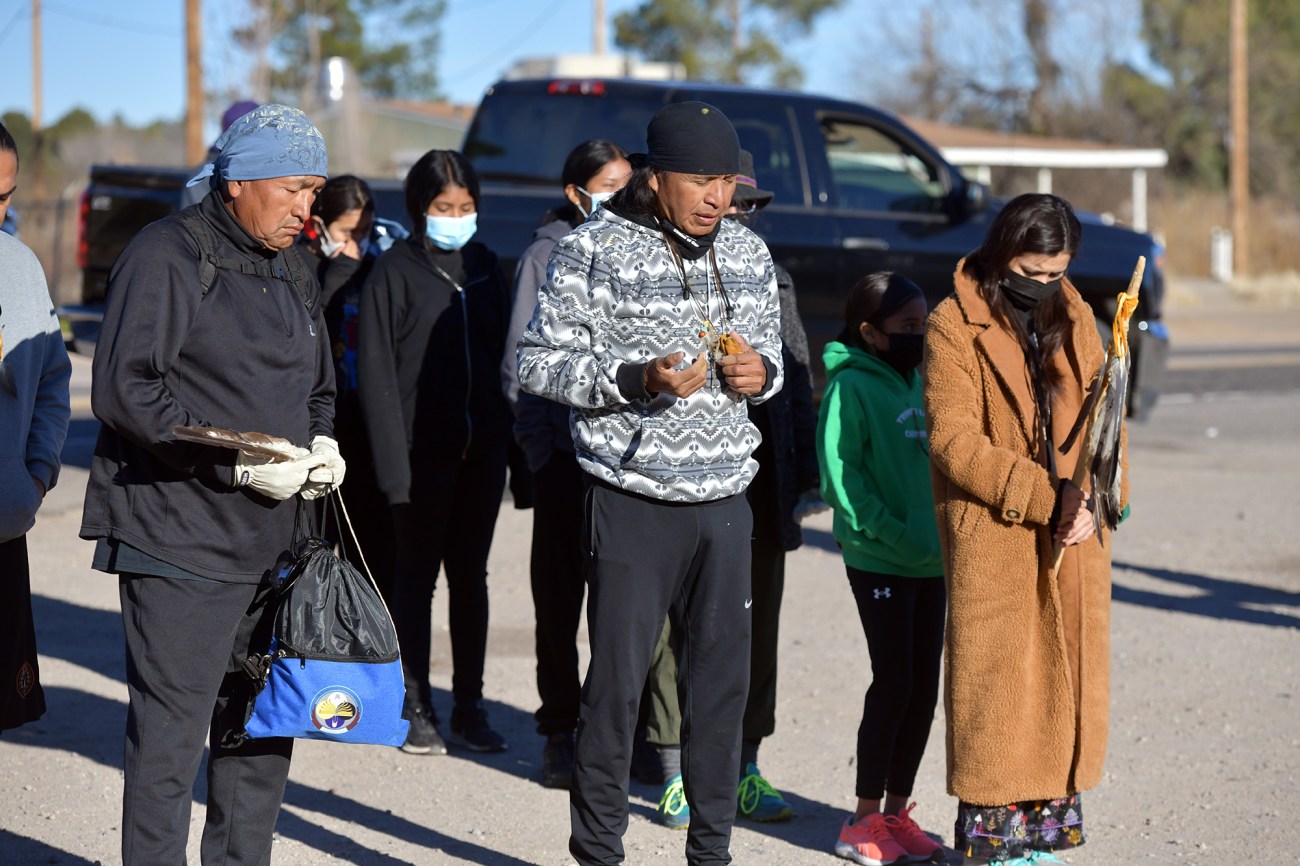
Wendsler Nosie Sr. (center) and his granddaughter Nizhoni Pike (right) prepare for the second day of the Oak Flat run in San Carlos, Arizona.
Ash Ponders
For centuries, Western Apaches have considered Oak Flat a portal to their creator, its springs holy and the acorns from its old-growth Emory oak trees a source of sustenance. They collect medicinal plants there and use the mesa’s meadows and overlooks for their most important rituals, including the sunrise ceremony that marks a girl’s maturation into adulthood. During Nizhoni’s ceremony, when she was 13, her godfather painted her with white clay taken from Oak Flat so that she represented the “white painted woman who emerged from the Earth in our creation stories,” she explains. “You’re covered in paint and dancing, your eyes are closed, you’re trying to breathe through your nose, but for me, it’s like I just gave all my trust into the ceremony,” she remembers. Then her godmother wiped the clay off her eyes. “From that moment, you no longer see the world as a girl—you see it as a woman.”
The San Carlos Apaches aren’t the only ones to revere Oak Flat; many other tribes consider it hallowed ground. A sanctuary in a sea of punishing desert, this rare riparian terrain is also home to several threatened and endangered species, including southwestern willow flycatchers, hedgehog cacti, and ocelots. Rock climbers and trail runners seek out its steep canyons and granite boulders. In 1955, President Eisenhower designated 760 acres of Oak Flat as public land to shield it from mining; during Nixon’s presidency, it landed on the National Register of Historic Places.
But these protections were no match for prospectors, who, in 1995, discovered a trove of copper. Rio Tinto, the British Australian mining conglomerate that is Resolution Copper’s majority owner, began a decade-long lobbying campaign to access the ore. In 2014, minutes ahead of a must-pass defense bill deadline, John McCain and Jeff Flake, then Arizona’s Republican senators, inserted a rider allowing Resolution Copper to trade acreage elsewhere in the state for Oak Flat. (Rio Tinto affiliates had donated to McCain’s campaigns, and Flake had once worked as a lobbyist for the company, the New York Times reported.) In January 2021, just as the Trump administration left office, the Forest Service published a draft environmental impact statement making way for the project.
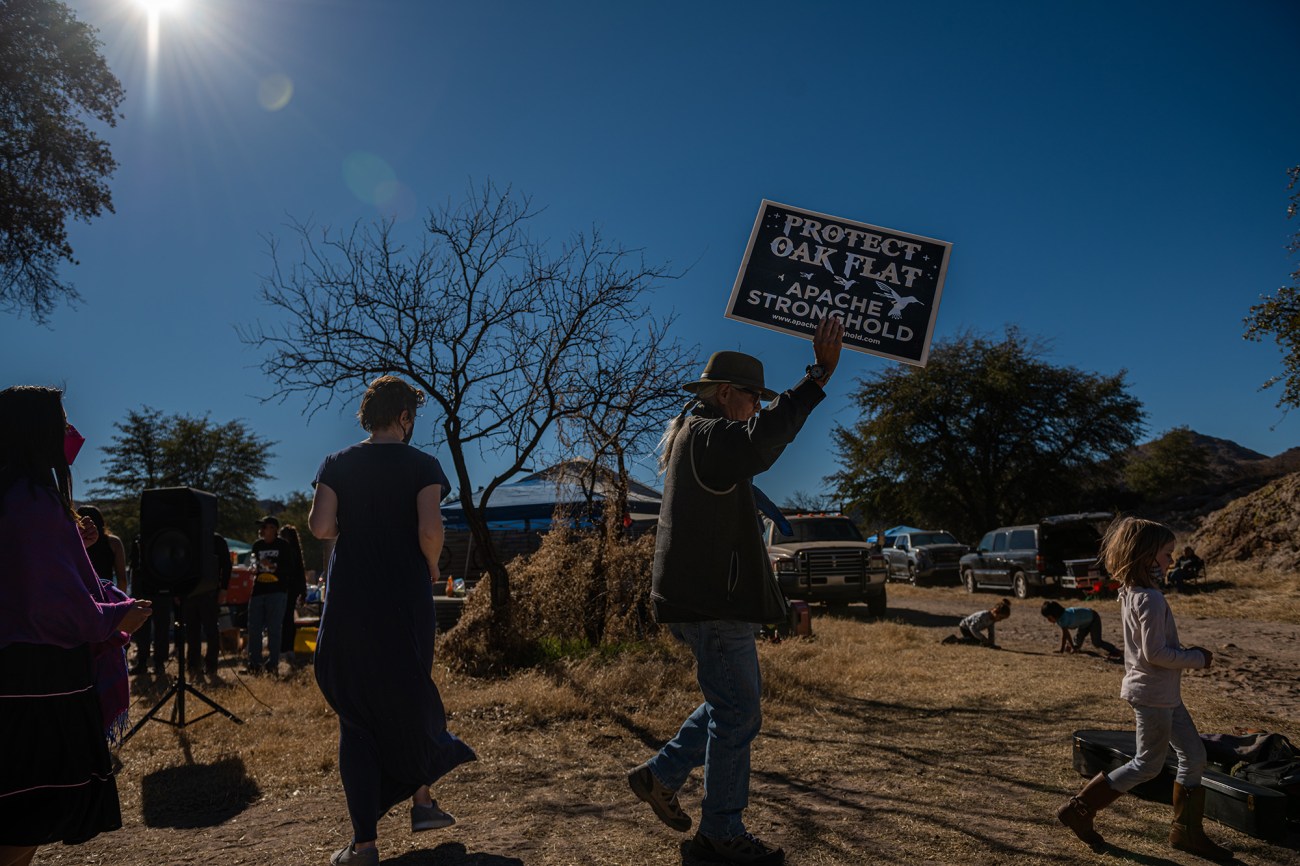
Jerry Thomas holds up an Apache Stronghold poster during a dancing celebration at the end of the Oak Flat Run.
Ash Ponders
Apache Stronghold sued, arguing the transfer and the mine violated their religious freedom and treaty rights. While a district court judge ruled against them, he did hold that “the Government’s mining plans…will have a devastating effect on the Apache people’s religious practices.” The San Carlos tribe and a coalition of environmental and mining reform groups filed separate lawsuits targeting the environmental impact statement. The dispute caught the eye of the newly elected president, and on March 1, the Forest Service rescinded the statement, temporarily halting the mine’s progress.
While President Biden has signaled that he will protect public lands, he has also been vocal about jump-starting a green economy—a quest that will require new sources of critical minerals. “Decarbonization is going to be much more copper intensive than people realize,” says Chris Berry, an energy metals analyst, with use spiking in batteries, grid infrastructure, and wind turbines. Demand from electric cars alone, which contain up to four times as much copper as gas models, is projected to rise from half a million tons today to as much as 3.3 million tons in 2030. “Copper is the new green,” the Resolution Copper website states.
Just as the United States’ appetite for copper grows, foreign suppliers of the metal have become less reliable due to under-investment and labor strife. For instance, Chile, the world’s leading copper producer, is rewriting its constitution and likely instituting a new royalty regime that will ramp up prices. Berry says these changes could discourage investors and delay a supply of new copper “just at the time that we’re seeing exponential demand for those end-uses that require copper, whether its electrical infrastructure or electric vehicles.”
It’s perhaps for that reason that Resolution Copper’s website boasts that “a steady home-grown copper supply will be a competitive advantage for US manufacturing.” After Russia invaded Ukraine, a group of Republican senators, citing copper, took the opportunity to urge Biden to “expedite the approval of domestic mines, including mines on federal land.”
Berry also notes that the mining industry is reckoning with demands that it focus more on mines’ potential effects on biodiversity and community health. As the industry is forced to clean up and adopt new standards, Berry says, “wouldn’t it make sense to have the material mined somewhere where you can actively monitor it and track it, as opposed to going to some jungle in Indonesia?”
Yet critics of Resolution Copper are skeptical that the mine will truly be a boon to the domestic supply chain. A Resolution spokesperson says the company “is looking to process” Oak Flat’s output in the United States. But given limits to domestic smelting capacity, many critics suspect the copper concentrate could be shipped to China. (State-owned Chinalco is Rio Tinto’s largest shareholder.) “Let nobody be under any illusion that this copper is staying in the US,” says Randi Spivak, public lands program director at the Center for Biological Diversity, which helped file a lawsuit to stop the land transfer in 2021.
While Resolution projects that the mine will create 3,700 jobs, its approach has stiffened opposition. In 2020, Rio Tinto blew up 46,000-year-old aboriginal rock shelters in Western Australia in pursuit of iron ore, sparking global outrage. When it comes to Oak Flat, Resolution plans to use block-cave mining, a highly destructive method that means drilling between 4,000 and 7,000 feet underground at the base of the vertical column of ore to trigger its collapse, eventually causing the surface to cave in.
The colossal project also threatens to deplete groundwater as the Southwest faces a historic megadrought. James Wells, a hydrologist commissioned by the San Carlos Apache, has flatly concluded that “Arizona does not have enough water to accommodate this large new demand.” (Resolution’s spokesperson disagreed, claiming the company has stored enough to sustain operations “for decades.”) Wells told Congress in April 2021 that the mine would consume what a city of 140,000 needs over 50 years. “The scale of this project is hard to fathom,” he cautioned.
As to suggestions that the mine’s copper could boost decarbonization, Naelyn wasn’t buying it: “It would cause a huge crater, two miles wide, as deep as the Eiffel Tower,” she says. “How can you tell me that’s going green?”
Apache Stronghold’s lawsuit now sits with the Ninth Circuit Court of Appeals, and a decision could land any day. The government’s argument in the case so far has been “extremely anti–Native American,” says Luke Goodrich, one of the group’s attorneys. “They take the position that the federal government has carte blanche to destroy any Native American sacred site on federal land.”
In February, the Biden administration began a round of consultations with tribal leaders, something that should have started years ago, according to Rep. Raúl Grijalva (D-Ariz.), who last year introduced the Save Oak Flat Act to permanently protect the area. “I hope it has an impact,” he says. “We’re dealing with a mining lobby that is powerful and has members [in Congress] that are not only supportive, but do their bidding.”
On the final day of the run, 18-year-old Aidan Parr, an enrolled member of the Coeur d’Alene tribe, jogs more than 26 miles, traversing the Superstition Mountains and passing cows and saguaro cacti. He and a few hundred other supporters convene for a closing event Saturday evening at Oak Flat, with the Apache Stronghold faction, members of several other tribes, and representatives of the Reverend William Barber’s Poor People’s Campaign joining from all four cardinal directions.
Parr and classmates from his high school’s Native American club have met with Arizona legislators to dissuade them from backing the mine, he tells me on the phone as he recovers from his first marathon. And, he says, “considering it’s a prayer run, we’re hoping a higher power gets involved.”
Earlier that morning, Naelyn and Nizhoni meet up with the Apache Stronghold contingent in the parking lot of the San Carlos Reservation’s skatepark. The sun has just begun to illuminate the murals lining the park’s walls, including one that reads “You’re skating on Native land.” Nosie faces 15 runners, who are standing in two parallel lines. “We have a big day ahead of us,” he tells them. They’ll be running out of the reservation and into the “copper triangle,” which includes a string of towns and open-pit mines that line the road that snakes to Oak Flat.
Running through these towns might help “wake up these people” to the reality that no resources are infinite, Naelyn had said to me the night before. Nizhoni chimed in: “It’s to open their eyes that this isn’t just about the Apaches, it’s about everybody. This is a bigger cause than they think.”
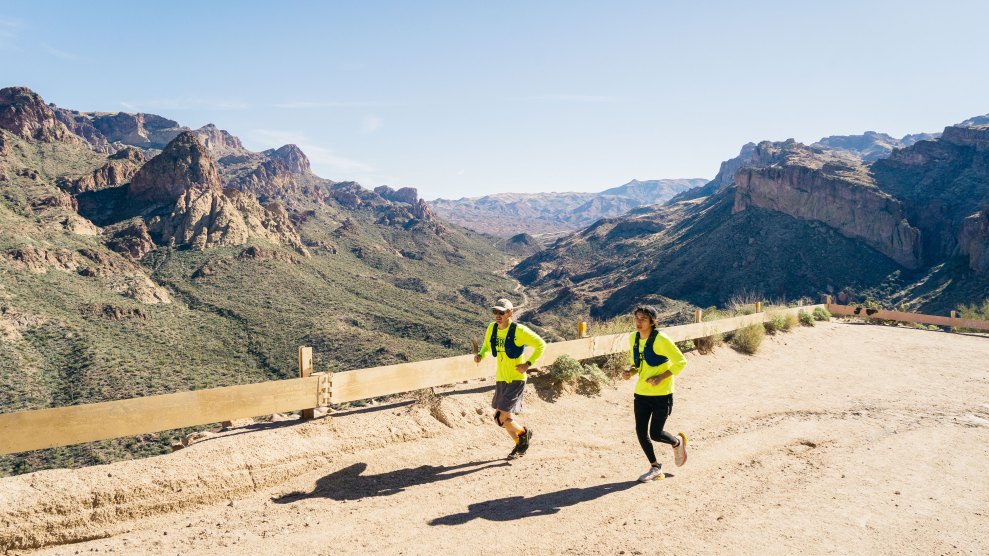
Aidan Parr (right) runs with his Brophy College Prep high school teacher, Cooper Davis, toward Oak Flat.
Shaun Marcus Price
Update, June 27: On Friday, in a 2-1 split decision, the Ninth Circuit Court of Appeals ruled that the government’s plan to transfer Oak Flat to Resolution Copper does not pose a “substantial burden” on the Apaches’ religious practice, meaning the transfer can go through. The decision, stated Beckett Law attorney Luke Goodrich, who helped represent Apache Stronghold in the case, “is, as the dissent says, ‘absurd,’ ‘illogical,’ and ‘incoheren[t]’: if anything violates the free exercise of religion, it is the complete destruction of a sacred site that ends religious practices forever.” Apache Stronghold plans to appeal to the Supreme Court.
